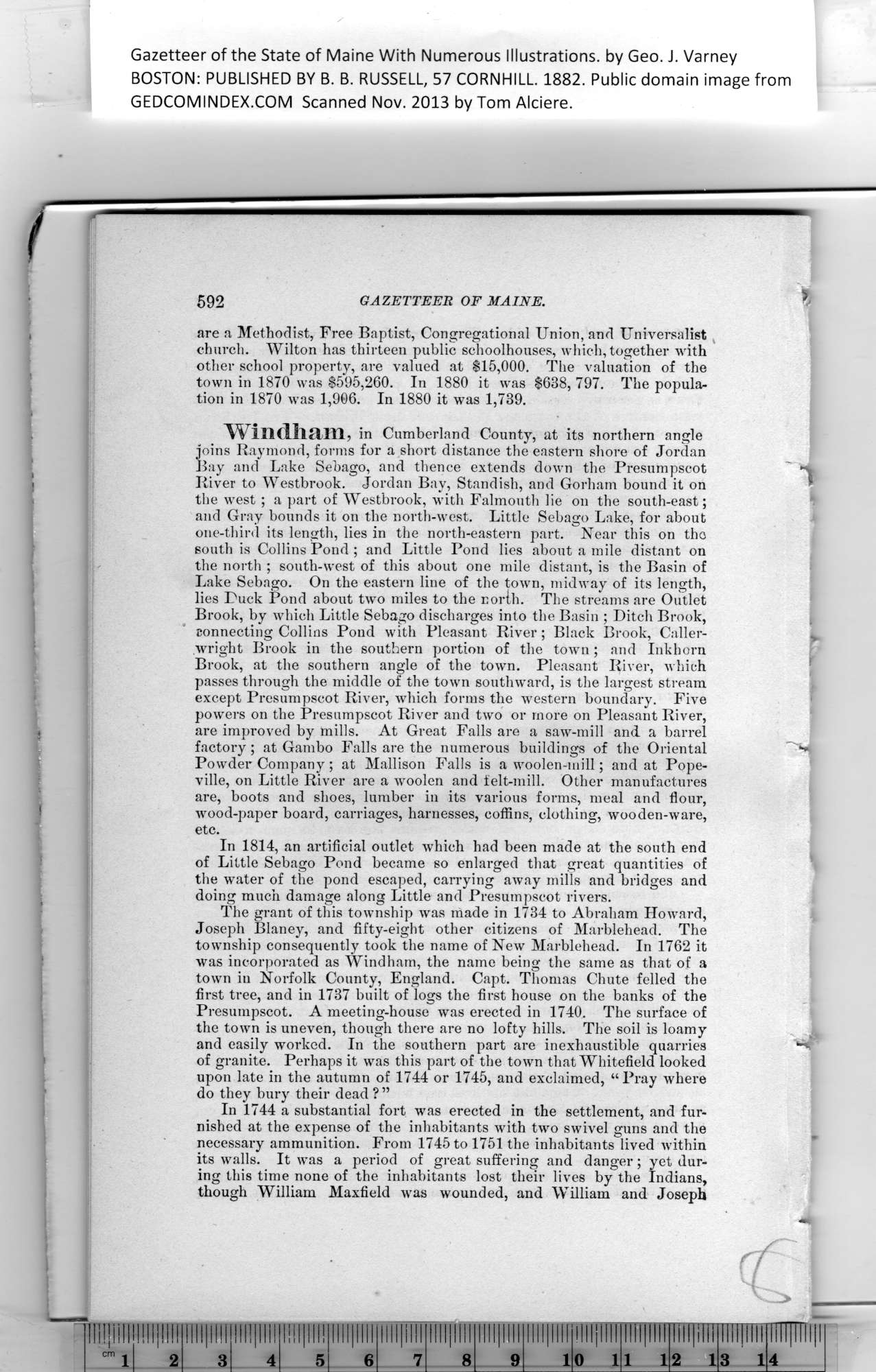|
Gazetteer of the State of Maine With Numerous Illustrations, by Geo. J. Varney
BOSTON: PUBLISHED BY B. B. RUSSELL, 57 CORNHILL. 1882. Public domain image from
592 GAZETTEER OF MAINE.
are a Methodist, Free Baptist, Congregational Union, and Universalist
church. Wilton has thirteen public schoolhouses, which, together with
other school property, are valued at $15,000. The valuation of the
town in 1870 was $595,260. In 1880 it was $638, 797. The popula-
tion in 1870 was 1,906. In 1880 it was 1,739.
Windham, in Cumberland County, at its northern angle
joins Raymond, forms for a short distance the eastern shore of Jordan
Bay and Lake Sebago, and thence extends down the Presumpscot
River to Westbrook. Jordan Bay, Standish, and Gorham bound it on
the west ; a part of Westbrook, with Falmouth lie on the south-east;
and Gray bounds it on the north-west. Little Sebago Lake, for about
one-third its length, lies in the north-eastern part. Near this on the
south is Collins Pond ; and Little Pond lies about a mile distant on
the north ; south-west of this about one mile distant, is the Basin of
Lake Sebago. On the eastern line of the town, midway of its length,
lies Puck Pond about two miles to the north. The streams are Outlet
Brook, hy which Little Sebago discharges into the Basin ; Ditch Brook,
connecting Collins Pond with Pleasant River ; Black Brook, Caller-
wright Brook in the southern portion of the town ; and Inkhorn
Brook, at the southern angle of the town. Pleasant River, which
passes through the middle of the town southward, is the largest stream
except Presumpscot River, which forms the western boundary. Five
powers on the Presumpscot River and two or more on Pleasant River,
are improved by mills. At Great Falls are a saw-mill and a barrel
factory; at Gambo Falls are the numerous buildings of the Oriental '"''Hi
Powder Company; at Mallison Falls is a woolen-mill; and at Pope-
ville, on Little River are a woolen and felt-mill. Other manufactures
are, boots and shoes, lumber in its various forms, meal and flour,
wood-paper board, carriages, harnesses, coffins, clothing, wooden-ware,
etc.
In 1814, an artificial outlet which had been made at the south end
of Little Sebago Pond became so enlarged that great quantities of
the water of the pond escaped, carrying away mills and bridges and
doing much damage along Little and Presumpscot rivers.
The grant of this township was made in 1734 to Abraham Howard,
Joseph Blaney, and fifty-eight other citizens of Marblehead. The
township consequently took the name of New Marblehead. In 1762 it
was incorporated as Windham, the name being the same as that of a
town in Norfolk County, England. Capt. Thomas Chute felled the
first tree, and in 1737 built of logs the first house on the banks of the
Presumpscot. A meeting-house was erected in 1740. The surface of
the town is uneven, though there are no lofty hills. The soil is loamy
and easily worked. In the southern part are inexhaustible quarries H
of granite. Perhaps it was this part of the town that Whitefield looked
upon late in the autumn of 1744 or 1745, and exclaimed, “Pray where
do they bury their dead ? ”
In 1744 a substantial fort was erected in the settlement, and fur-
nished at the expense of the inhabitants with two swivel guns and the
necessary ammunition. From 1745 to 1751 the inhabitants lived within
its walls. It was a period of great suffering and danger; yet dur-
ing this time none of the inhabitants lost their lives by the Indians,
though William Maxfield was wounded, and William and Joseph
PREVIOUS PAGE ... NEXT PAGE
This page was written in HTML using a program written in Python 3.2
| 